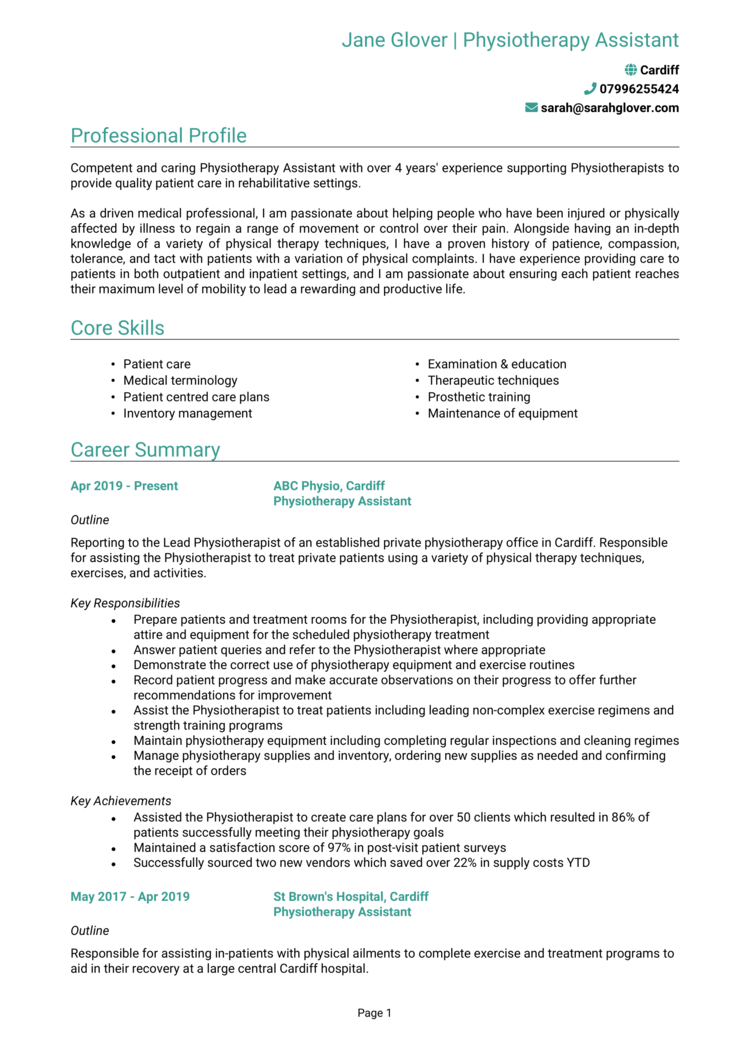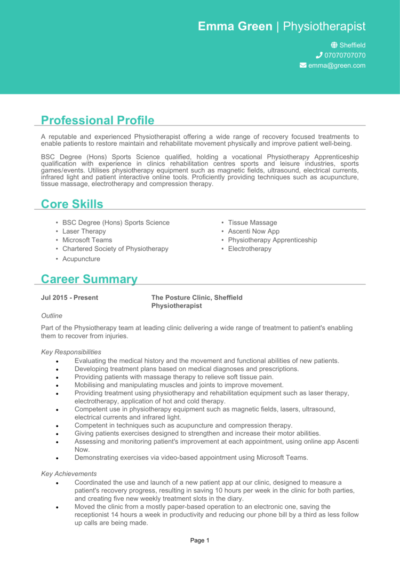As a physiotherapist, you help patients recover, improve mobility, and live their best lives. Now it’s time to give your CV a similar treatment – get it in shape to perform at its best.
Think of this guide as your professional warm-up – it’ll get your CV in top shape and ready to go the distance. Complete with some Physiotherapist CV examples, you’ll learn how to showcase your skills, highlight your experience, and land interviews for rewarding roles that let you make a real impact on patients’ lives.
Physiotherapist CV

Physiotherapy Assistant CV

How to write your Physiotherapist CV
Learn how to create your own interview-winning Physiotherapist CV with this simple step-by-step guide.
This guide will help you with writing a CV that gets you noticed, secures interviews, and helps you land your next role in physiotherapy.
You’ll finish with a Physiotherapist CV that highlights your clinical expertise, interpersonal skills, and dedication to patient care. Employers want to know you’re skilled in assessing injuries, developing treatment plans, and supporting rehabilitation.
Physiotherapist CV structure


Your CV is like a treatment plan – it should be tailored and precise, and ultimately leave the recruiter feeling better about their decision to hire you. It should be packed with all the information a recruiter needs, and it should all be easy to find.
Here’s how to lay out your Physiotherapist CV structure:
- Name and contact information – Display your contact details clearly at the top so employers can get in touch easily. Including a picture of yourself is always optional.
- Profile – Craft a short introduction to summarise your clinical experience, expertise, and career aspirations.
- Core skills – Highlight your key abilities, such as musculoskeletal assessment, manual therapy, and patient education.
- Work experience – Outline your primary responsibilities in reverse chronological order, focusing on patient outcomes and responsibilities.
- Education – List the academic qualifications, certifications, and relevant CPD (Continuing Professional Development) and awards you’ve earned.
- Additional info – Optionally, include hobbies and interests that reflect your passion for health and wellness.
How to format your Physiotherapist CV


A disorganised CV format is like a poorly executed stretch – awkward, uncomfortable, and possibly painful to even look at. Keep it sleek and professional to leave a great impression. A clean and easy-to-read layout ensures recruiters can focus on your qualifications and experience, so avoid simple mistakes.
Here’s how to format your Physiotherapist CV effectively:
- Bullet points – Employ short, punchy bullet points to make responsibilities and achievements easy to read.
- Divide sections – Structure your CV with distinct sections that make it easy to scan.
- Use a clean font – Choose a professional, readable font that keeps the focus on your content.
- Keep it the right length – No more than 2 pages in length, ensuring your highlights are front and centre while avoiding unnecessary fluff. Save the rest for a cover letter.
The best way to write a Physiotherapist CV profile


Your profile (or personal statement for less experienced candidates) is like the opening diagnosis – it’s your chance to show recruiters you understand exactly what they’re looking for and why you’re the one to deliver it. You need to convince them of the benefits you’d bring to any company that hires you.
Physiotherapist CV profile examples
Profile 1
Experienced Physiotherapist with six years of expertise in musculoskeletal rehabilitation, working in outpatient clinics and sports injury centres. Skilled in developing personalised treatment plans, using manual therapy techniques, and guiding patients to achieve a 90 percent recovery rate.
Profile 2
Dedicated Physiotherapist with four years of expertise in neurological rehabilitation, focusing on stroke recovery and mobility improvement. Proficient in using therapeutic exercises, gait training, and assistive technologies to help patients regain independence.
Profile 3
Proficient Physiotherapist with over eight years of experience in paediatric physiotherapy, specialising in treating children with developmental delays and physical disabilities. Skilled in creating engaging therapy programs and collaborating with families to maximise outcomes.
What to include in your Physiotherapist CV profile
Here are some tips on what to include in your Physiotherapist CV profile:
- Where you’ve worked – Note which kind of hospitals, private clinics, or sports organisations you’ve been part of.
- Your top qualifications – Then, highlight your degree in Physiotherapy or equivalent certifications.
- Specialisations – Quickly mention areas like paediatrics, sports injury rehab, or neurophysiotherapy.
- Patient outcomes – Note any measurable improvements you’ve helped patients achieve.
- Clinical tools – You should also reference expertise with equipment or techniques, such as ultrasound therapy or Pilates-based rehab.
Core skills section


Your CV skills section should reflect your clinical expertise and ability to provide top-tier care. Tailor this section to align with the specific requirements of the role, whether it’s musculoskeletal rehab or working with athletes.
Skills to include in a Physiotherapist CV
- Patient Assessment – Evaluating physical conditions through detailed examinations and patient history analysis.
- Rehabilitation Planning – Designing customised treatment plans to aid recovery and improve mobility.
- Manual Therapy Techniques – Performing hands-on techniques such as joint mobilisation and soft tissue manipulation.
- Exercise Prescription – Developing tailored exercise programmes to strengthen muscles and enhance flexibility.
- Electrotherapy – Using modalities like ultrasound, TENS, or laser therapy for pain relief and tissue repair.
- Post-Surgical Rehabilitation – Guiding patients through recovery plans after surgeries to restore function and mobility.
- Gait Analysis – Assessing and correcting walking patterns to prevent injury and enhance performance.
- Neurological Rehabilitation – Treating patients with conditions like stroke, multiple sclerosis, or Parkinson’s disease.
- Ergonomic Advice – Educating patients on workplace adjustments to prevent musculoskeletal issues.
- Health Education – Providing guidance on injury prevention, lifestyle changes, and overall well-being.
Work experience


Your work experience section is where you demonstrate how you’ve applied your skills to improve patient outcomes. Focus on your responsibilities, contributions, and measurable successes.
In your CV’s job history section, make sure to keep your newer roles toward the top, and provide more detail for the most relevant ones.
How to format previous jobs in your CV correctly

- Outline – Give a brief description of the setting, your role, and the types of patients you worked with.
- Responsibilities – Make sure you highlight key tasks, such as creating treatment plans, delivering manual therapy, or collaborating with multidisciplinary teams.
- Achievements – It’s essential to add measurable outcomes, like reduced recovery times or increased patient satisfaction scores. A good CV will sprinkle in plenty of numbers to make the achievements more tangible.
Example jobs for Physiotherapist
Physiotherapist | Active Recovery Clinic
Outline
Provided physiotherapy services in a private outpatient clinic specialising in musculoskeletal and sports injury rehabilitation. Focused on delivering tailored treatment plans to support patient recovery and well-being.
Responsibilities
- Assessed patient conditions through detailed examinations and diagnostic tests.
- Developed and implemented personalised rehabilitation programs, including exercise therapy.
- Performed manual therapy techniques to alleviate pain and restore mobility.
- Educated patients on injury prevention and at-home exercises to enhance recovery.
- Collaborated with other healthcare professionals, including orthopaedic surgeons and chiropractors.
Achievements
- Improved patient recovery times by 20 percent through evidence-based treatment plans.
- Achieved a 95 percent patient satisfaction rate, consistently exceeding clinic standards.
- Recognised for successfully treating complex cases, including post-surgical rehabilitation.
Physiotherapist | NeuroCare Clinic
Outline
Worked in a multidisciplinary team to provide physiotherapy services for patients with neurological conditions. Focused on improving motor function and enhancing quality of life.
Responsibilities
- Conducted assessments to identify mobility impairments and treatment goals.
- Designed and implemented therapy programs for stroke survivors and patients with Parkinson’s disease.
- Provided gait training and balance exercises to improve patient stability.
- Used assistive technologies, including exoskeletons and mobility aids, to support therapy.
- Educated patients and caregivers on long-term strategies for maintaining mobility.
Achievements
- Increased patient independence by 30 percent through targeted rehabilitation plans.
- Developed a community exercise program attended by 50+ neurological patients weekly.
- Praised by colleagues for innovative approaches to improving patient outcomes.
Physiotherapist | Motion Paediatrics
Outline
Specialised in paediatric physiotherapy at a clinic focused on helping children with developmental delays, physical disabilities, and congenital conditions. Delivered engaging and effective therapy sessions to achieve measurable progress.
Responsibilities
- Assessed motor skills and physical development in children, creating customised therapy plans.
- Incorporated play-based therapy techniques to maintain engagement during sessions.
- Collaborated with families and teachers to implement therapy strategies in daily routines.
- Used adaptive equipment, such as orthotics and standing frames, to support therapy goals.
- Maintained detailed progress reports to track improvements and adjust treatments.
Achievements
- Helped 80 percent of patients achieve developmental milestones within six months.
- Introduced new therapy techniques that improved patient engagement by 25 percent.
- Recognised by families for providing compassionate and effective care.
Education section


The education section is vital for physiotherapists, as it demonstrates your academic foundation and professional training.
Outline any of your degrees, pre-registration training, and any additional certifications like first aid or CPD courses. For new graduates, highlight academic projects or clinical placements.
You should always list qualifications in reverse chronological order, starting with the most recently-earned.
The best qualifications to boost a Physiotherapist CV
- BSc (Hons) in Physiotherapy – The essential qualification for practising physiotherapy in the UK.
- Chartered Society of Physiotherapy (CSP) Membership – Demonstrates your adherence to professional standards.
- HCPC Registration – Required for practising physiotherapists in the UK.
- Sports Therapy Certification – Highlights expertise in injury prevention and rehabilitation for athletes.
- Advanced Manual Therapy Training – Validates skills in specialised techniques for musculoskeletal care.





